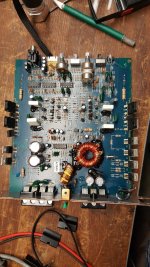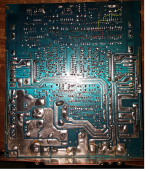I have been repairing home/professional audio equipment for 15 years as a hobby. I have learned the power of schematics. Just wondering for those that repair mobile audio equipment how does one start to diagnosis without a schematic? Are there any universal schematics since alot of mobile power amps are similar. I purchased a new used Dual XPR522 and it has operated well for months. Now there is an intermittent static noise on the right channel. Removed amp and put it on the bench and powered it up with speakers and confirmed it is the amp. Monitored DC offset on right channel and at power up 15mV after several minutes it increases to 150/200mV. Took it out of the aluminum shell and have it bare board on the bench. Nothing smoked or discolored. Wanted to inspect solder connections and traces......suspicious of a bad solder joint.
Being one channel it is not power supply related. Most likely something in the amplifier stages.
The intermittent static noise is not affected by volume.
and I already know that this amp is probably considered a throw away but I am one of those individuals that cant bring themselves to throw away a piece of electrical equipment that possibly just has a bad solder connection.
Being one channel it is not power supply related. Most likely something in the amplifier stages.
The intermittent static noise is not affected by volume.
and I already know that this amp is probably considered a throw away but I am one of those individuals that cant bring themselves to throw away a piece of electrical equipment that possibly just has a bad solder connection.
Is the noise affected by twisting the board (would tend to make intermittent connections make/break)?
Where does the noise enter the circuit on the board? You may have to map the left/right channels by feeding one channel at a time and making note of where the left and right channels are.
Where does the noise enter the circuit on the board? You may have to map the left/right channels by feeding one channel at a time and making note of where the left and right channels are.
Thanks Perry the diymobile site said you were the one to work with.You can just do it roughly. initially, by marking the l/r channels on the output of the op-amps with a paint-pen or something similar.
After the op-amps, the l/r are clearly separated.
Question have not powered up on the bench since the heatsinks have been removed. These are bjt outputs.
Would you power this up without heatsinks? Concerned about the transistors overheating.
Of course nothing more than idling. Would like to feed small input signal at some point.
Was wanting to determine what the function is for the single T0-92 that is on the heatsink, one on each channel.
Bias control? Overtemp?
If it's bias control then no heatsink may be a problem?
This appears to have no bias pots. If so, there won't likely be any bias current so heating of the output transistors shouldn't be an issue, but you should monitor them when it's powered up, until you know if they will heat up any.
The PS FETs will also need to be watched initially. Some heat and some don't.
The mapping could be done in the sink. Using temporary heatsinks is also an option if there is heating and troubleshooting needs to be done without the sink.
The TO-92 could be for bias compensation. The only amps I know that use a transistor for thermal protection are those made by Brazilian manufacturers. This is likely Asian.
The PS FETs will also need to be watched initially. Some heat and some don't.
The mapping could be done in the sink. Using temporary heatsinks is also an option if there is heating and troubleshooting needs to be done without the sink.
The TO-92 could be for bias compensation. The only amps I know that use a transistor for thermal protection are those made by Brazilian manufacturers. This is likely Asian.
Figured this day would come eventually...looking at mobile audio. My passion has been home and pro audio. Just purchased this amp couple months back...used...FB. It was well cared for or had little use $40. Noise developed after using it for two months without any issue. Pull it apart and it looks brand new...no evidence of tampering or overheating...has to be more service life to this amp.
Definately an edge to be able to work with somebody with experience with troubleshooting mobile audio. Thanks Perry!
Definately an edge to be able to work with somebody with experience with troubleshooting mobile audio. Thanks Perry!
I was using a 14V DC supply to bench test but swapped with a variable DC supply but now realize it has a .5A maximum.
Any concerns about using a 14V DC supply for bench testing?
Any concerns about using a 14V DC supply for bench testing?
No. Some vehicles commonly charge at 14.5v.
Install a 10 or 15 amp fuse in the B+ line and monitor the temperature of the heatsink mounted semiconductors.
Install a 10 or 15 amp fuse in the B+ line and monitor the temperature of the heatsink mounted semiconductors.
Back using the 14V DC 4A power supply. Amp powers up after several minutes...if speakers are attached a burst of static noise will be heard...heat induced? One channel only. I have monitored DC Offset originally and did see spikes of offset 300-400mV.
Tonight a DVM was placed on 14VDC supply. At start up .5A and no noise. After several minutes static burst of noise and the accompanying burst of current....short burst to .8 A.
Have you ever seen this before?
I have not had alot of time to try to trace circuitry on the pcb.
Amp has a pair of bjt's for outputs KB688 (PNP) and D718(NPN).
I could monitor the emitter voltage on each of these to see if it's the positive or negative side of the channel or are both outputs involved..
Any suggestions?
Tonight a DVM was placed on 14VDC supply. At start up .5A and no noise. After several minutes static burst of noise and the accompanying burst of current....short burst to .8 A.
Have you ever seen this before?
I have not had alot of time to try to trace circuitry on the pcb.
Amp has a pair of bjt's for outputs KB688 (PNP) and D718(NPN).
I could monitor the emitter voltage on each of these to see if it's the positive or negative side of the channel or are both outputs involved..
Any suggestions?
Back using the 14V DC 4A power supply. Amp powers up and after several minutes...if speakers are attached a burst of static noise will be heard...heat induced? One channel only. I have monitored DC Offset originally and did see spikes of offset 300-400mV.
Tonight a DVM was placed on 14VDC supply. At start up .5A and no noise. After several minutes static burst of noise and the accompanying burst of current....short burst to .8 A.
Have you ever seen this before?
I have not had alot of time to try to trace circuitry on the pcb.
Amp has a pair of bjt's for outputs KB688 (PNP) and D718(NPN).
I could monitor the emitter voltage on each of these to see if it's the positive or negative side of the channel or are both outputs involved..
Any suggestions
Tonight a DVM was placed on 14VDC supply. At start up .5A and no noise. After several minutes static burst of noise and the accompanying burst of current....short burst to .8 A.
Have you ever seen this before?
I have not had alot of time to try to trace circuitry on the pcb.
Amp has a pair of bjt's for outputs KB688 (PNP) and D718(NPN).
I could monitor the emitter voltage on each of these to see if it's the positive or negative side of the channel or are both outputs involved..
Any suggestions
Do you see where the signal passes from the preamp to the power amp? If so, do you see the noise there on the noisy channel?
Does it make the noise out of the heatsink?
Do you have any cooling spray or canned air?
Does it make the noise out of the heatsink?
Do you have any cooling spray or canned air?
I have an oscope is it ok to ground the scope probe to the ground on the input side(the shields of the rca's?
I measured the resistance from the input shields to the speaker output negative it measured 200 ohms.
I measured the resistance from the input shields to the speaker output negative it measured 200 ohms.
I left my scope ground connected to the ground terminal of the 12v power supply. The only times it didn't work for general troubleshooting is when an amp had a completely isolated secondary and that's rare.
In those cases, I'd ground the scope to a non-bridging speaker terminal.
It's generally OK to ground to the shields but not if the amp has balanced inputs.
Does it make the noise out of the heatsink?
Do you have any cooling spray or canned air?
In those cases, I'd ground the scope to a non-bridging speaker terminal.
It's generally OK to ground to the shields but not if the amp has balanced inputs.
Does it make the noise out of the heatsink?
Do you have any cooling spray or canned air?
Does it make the noise when the amp is outside of the heatsink (no heatsink)?
You can alternately heat and cool (invert canned air) various components to see if you can find any thermally sensitive.
You can alternately heat and cool (invert canned air) various components to see if you can find any thermally sensitive.
- Home
- General Interest
- Car Audio
- Dual XPR 522 static noise one channel

